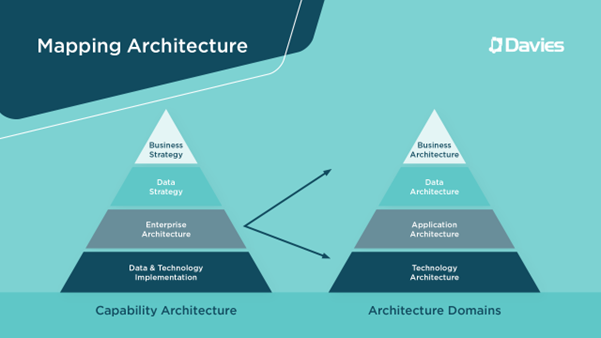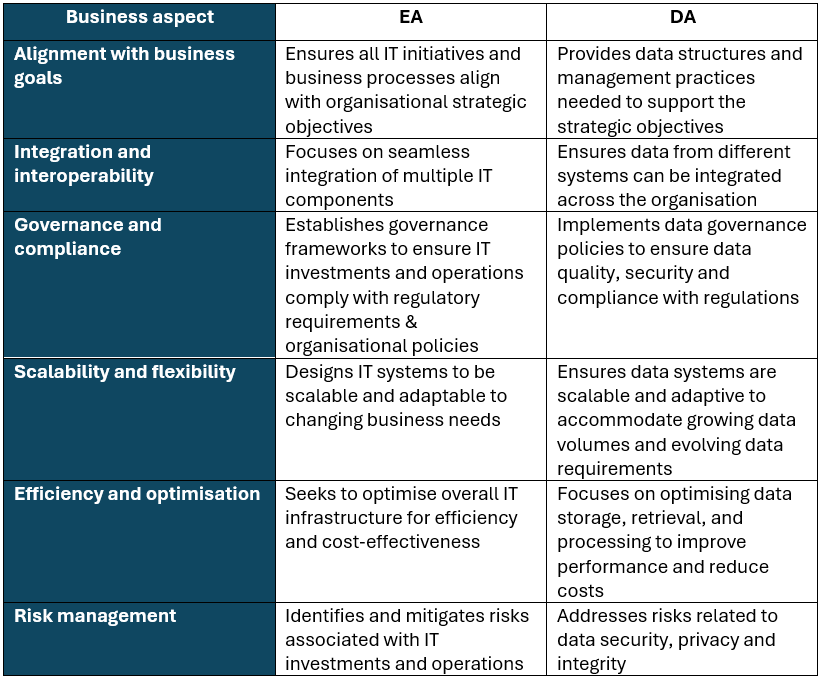Data is a critical resource for any business—driving decision-making, innovation, and competitive advantage. However, organisations that generate a large volume of data, or utilise complex datasets, often face significant challenges in managing their data effectively. Without a robust data management framework in place, this task can quickly become overwhelming. This is where data architecture comes in.
Here, we will be exploring the fundamental concepts of data architecture and its importance. We’ll also examine how it can transform the way businesses operate and thrive in a data-driven world.
What is data architecture?
Data architecture is the framework that manages data within an organisation. It comprises the structure, interaction, and management of a business’s data assets. It also considers how these elements feed into the organisation’s overall objectives and strategy.
More specifically, it focuses on the rules and processes for standardising how to collect, store, and use data as it flows through the organisation. It determines how data is identified to support data discovery—what data there is, where it’s stored, and what are the different data fields that exist—and how data is defined, to support the understanding of it.
With data architecture guiding the design and implementation of systems for managing, storing, and retrieving data, it plays a critical role in shaping how data is handled across the organisation. As such, there are overarching principles for effective data management that need to be considered:
- Data quality: Ensuring data is accurate, consistent, complete, and timely.
- Data security: Protecting data from unauthorised access, modification or loss.
- Data accessibility: Making data readily available to authorised users in an efficient manner.
- Data governance: Implementing policies, procedures and roles to manage data at all points of its lifecycle.
- Data integration: Connecting and combining data into a single, unified view.
In addition, data architecture principles also call for data to be flexible, scalable, and cost effective.
What is the relationship between enterprise data and data architecture? How do they differ?
Enterprise architecture and data architecture are closely related disciplines within the wider field of information technology and organisational management. They operate at a different scope and level. Both are also crucial for ensuring an organisation’s IT and business infrastructure remains aligned with its business goals and operates efficiently.
Enterprise Architecture (EA)
This framework is used to manage and align an organisation’s IT assets, people, operations, and projects to its overall business goals. It is an umbrella term used to refer to four key domains (or, architecture types) that sit within it. The diagram below shows these architecture domains in greater detail.

Image 1.0. A diagram showing how EA fits into the overall organisational strategy. As well as how it expands into four main architecture domains, including data architecture.
Data architecture (DA)
Data architecture is a subset of enterprise architecture that specifically deals with the organisation, storage, integration, and management of data. Key components include:
- Data models: Conceptual, logical, and physical models that define how data is structured and related.
- Metadata Management: Information about the data (definitions, lineage & ownership)
- Data storage solutions: Databases, data warehouses, data lakes, and other storage systems.
- Data integration: How data moves between systems
- Data tools and technologies – Platforms and tools used
EA vs DA
As the enterprise and data architecture diagram above shows, DA is a component of EA. While they are closely related, they differ in overall scope, focus and purpose within an organisation. EA effectively sets the context in which DA operates.

Why is data architecture important?
It provides a blueprint for an organisation on how to manage and use their data effectively. This framework ultimately supports business goals and decision-making. It breaks down data silos, helps to seamlessly integrate data across departments and ensures businesses can maintain consistent data quality and security. And, when done well—data architecture also enables better data governance, increases regulatory compliance and gives organisations the flexibility needed to adapt to the evolving business and market needs.
Data architecture also:
- Provides a consistent enterprise view of data: It creates a unified understanding of what data assets exist and how they flow within the organisation, ensuring all teams work from the same information baseline. This helps to break down silos and ambiguity within data knowledge and usage.
- Links the tech and data to business processes: It sets a blueprint for how data assets and systems align with the business model and operational workflows that keep the organisation running smoothly.
- Simplifies integration management: A well-defined architecture reduces the complexity inherent in most data technology designs by mapping out how systems integrate to maintain interoperability and provide transparency.
- Establishes framework for foundational data domains: It defines the core data categories, their relationships, and their management. This provides a base layer for essential domains—without data architecture, these domains wouldn’t be able to “talk” to each other, in the same language.
- Standardises downstream requirements gathering: It gives analysts and scientists a common language and framework for communication and enables them to understand and learn how upstream data is structured. This creates foundational trust in the data and facilitates the business link necessary to build analytical solutions.
- Informs AI tools: It acts as blueprint for relevant data and information within the business, which helps to ensure AI usage is more accurate and effective.
A robust data architecture is the foundation of a comprehensive data strategy and is crucial for supporting an organisation’s business goals and priorities.
Here at Davies, our Asset and Wealth Management practice provides data architecture design, analytics, and Data Management Services to help you get a handle on your data. No matter how complex or large your datasets are. Want to find out more about what we can do for you? Get in touch today!



